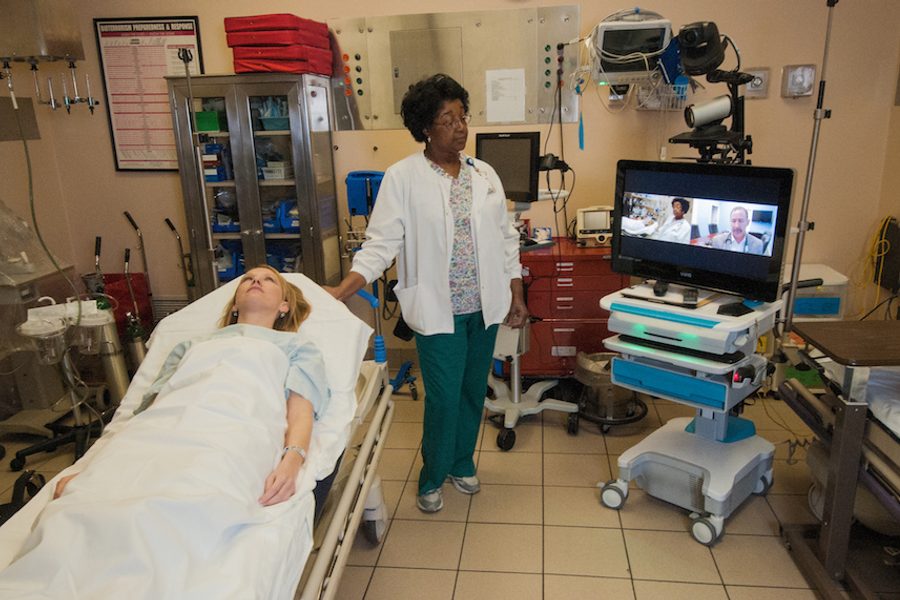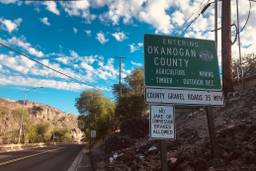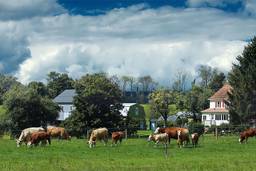Rural Emergency: Hospital Closures Are Putting Farmers Out of Business
Debbie Weingarten

Kendra Colburn spent a decade uninsured. During those years, she worked as a carpenter near her hometown in rural Vermont, earning just enough that she didn’t qualify for low-income health care, but not enough to afford health insurance on her own. While uninsured, she suffered two major work injuries that landed her in the emergency room — once, a nail shot through three of her fingers, and another time, a piece of wood kicked back on the table saw and sliced her arm. When she was unable to pay the emergency room costs, her credit took a hit for years.
Today, Colburn works on her brother’s farm and is covered by Medicaid. As a manual laborer, Colburn has developed nerve damage, which flares up in her hands and wrists with overuse. “I cut back my hours to deal with it. I can’t afford to not be able to use my hands,” she says. “That’s how I make all of my money.”
As a child who grew up in a farming community, Colburn says she observed that pain is just a part of being a farmer. “It’s taken for granted that your body hurts every day, that your back always hurts.” That’s true for workers employed in some of the most dangerous jobs: Many manual laborers with high rates of injury and repetitive stress injuries are also more likely to be uninsured. In fact, a 2015 study found that 65 percent of commercial farmers identified health insurance costs as the most serious threat to their farms.
Alana Knudson, co-director of the Walsh Center for Rural Health at NORC at the University of Chicago, prefers to discuss rural health care in terms of strengths, but she does recognize the real barriers demonstrated by statistics. “Overall, we know that people who live in rural communities are likely to have lower incomes than their urban counterparts,” she says. Rural residents are also more likely to have multiple chronic conditions and lower educational attainment, and they’re more likely to face barriers in accessing transportation to medical care.
But there are also less tangible barriers. Colburn says that many people she knows don’t feel comfortable navigating the complicated web of professional medical interventions when experiencing health issues. And the Medicaid system can often lack efficiency. Colburn says her state’s website often doesn’t work, and she still hasn’t figured out how to find a primary care doctor who takes her insurance. Once, a computer glitch resulted in her being removed from her insurance plan, and she was charged hundreds of dollars in out-of-pocket expenses. Even though it was an error on Medicaid’s part, Colburn was still responsible for the bill. “Generally when we’re talking about rural health care issues, we’re talking about access, as if once you get access that actually means something. But when you get access, it still can be a nightmare,” she says.
Faced with whether to seek medical attention or “make do,” Colburn says many people simply don’t go. She notes that farmers especially have a hard time leaving their farm obligations to take care of themselves. They also spend significant time outdoors, and it’s difficult to imagine a hospital stay. Colburn says, “I have treated myself or not gone a million times.” One spring, she stepped on a potato fork and punctured her foot. Instead of going to the doctor, she spoke with a community herbalist, used an herbal tincture, and soaked her foot in salt water.
“I know for a fact that I need a root canal,” Colburn says, “It used to hurt and now it doesn’t hurt, so I just deal with it.” She pauses. “I know a lot of people who just get their teeth pulled. And the dental piece is important because what your teeth look like has [a] direct impact on what opportunities you have.”
This reality is echoed by rural journalist Sarah Smarsh. “In the past year, the Affordable Care Act, or ‘ObamaCare’, has changed many lives for the better — mine included,” she wrote in an essay for Aeon. “But its omission of dental coverage, a result of political compromise, is a dangerous, absurd compartmentalization of health care, as though teeth are apart from and less important than the rest of the body.”
The fabric of rural America is shifting, in large part due to changes in agriculture. Knudson grew up in North Dakota and says she’s seen that change firsthand. “Our neighbors are farming our land and they seed over 10,000 acres. A lot of the small farms are not there anymore.”
Many children of farmers choose not to take over the farm. Land is then sold or leased to larger farms. Small businesses that once depended on a critical mass of farm families as customers also go out of business. The effects of this rural migration are particularly severe on rural elderly with complex medical needs — and no younger generation remaining in the area to care for them.
Last year, a photographer and I drove across Kansas and Iowa to report on the hidden crisis of farmer suicide. We visited Onaga, Kan., a small town with a newly renovated hospital. Just blocks from the hospital’s beautiful lobby and squeaky-clean floors were empty streets and boarded up storefronts. One doctor said the hospital had a hard time attracting medical professionals to practice there. The therapist had left months ago, she said, and they were struggling to fill the position.
An online search for “benefits for rural medical professionals” turns up a slew of sites about attracting medical talent to rural communities. Rural medical establishments are advised to advertise the lower cost of living and ability to buy acreage, less traffic, a quieter life, student loan forgiveness in certain underserved areas, “the potential to become the ‘town hero,’” more time spent with patients, and increased proficiency due to physicians seeing “a broader scope of illness.”
Still, rural communities are facing the closure of hospitals and clinics. In 2016, The National Rural Health Association (NRHA) announced that 673 rural hospitals were at risk to close. Of those, 210 were at “extreme risk” of closure. The NRHA warns that “Medical deserts are forming across the nation, significantly adding to the health care workforce shortage in rural communities. Seventy-seven percent of rural U.S. counties are already considered Primary Care Health Professional Shortage Areas.”
Knudson says the health care industry is undergoing a significant transformation in terms of how medical care is being reimbursed. “Our reimbursement system is moving from a volume to value,” she says. “Historically hospitals have been reimbursed by the number of hospitalizations they provided — you have 10 hospitalizations and you get reimbursed for 10 stays. Our country has really shifted as much as possible to outpatient to make health care more affordable.”
That means a decrease in admissions, more outpatient procedures, and less reimbursable care for hospitals. Additionally, Knudson says many of the rural hospitals closing are in states that have not expanded Medicaid, which has led to a higher number of uninsured patients. “When people are uninsured, it’s difficult to collect payment for that hospitalization.”
Hospital closures can be devastating to rural communities, creating gaps in access to the detriment of residents. “Many of these hospital closures are happening in areas with the highest concentration of heart disease and diabetes, and in some of the poorest communities in the country,” says Maggie Elehwany of the NRHA. “When that hospital closes, it’s like putting a nail in the coffin of that community. You can’t attract businesses or families with kids or keep retirees. So we’re fighting not only for rural hospitals, but also for the economies of these rural communities as well.”
In June 2017, Missouri Congressman Sam Graves introduced the Save Rural Hospitals Act (H.R. 2957). The bill doesn’t increase reimbursements, but it does offer stability for “the closure crisis” by eliminating cuts and Medicare Sequestration for rural hospitals. It also establishes a new Medicare payment designation, called the Community Outpatient Hospital, that would guarantee rural access to emergency care and give hospitals the choice to offer outpatient care. The bill was co-sponsored by 21 representatives (14 Republicans and 7 Democrats), but it is still waiting for a vote.
Rural residents can’t afford to wait, so they are using the assets they have. Rural communities are known for being innovative, self-sufficient, and used to organizing quickly in an emergency. Families may have been rooted in one area for generations, which manifests in a deep knowing of their neighbors, as well as each other’s talents and stressors. And rural communities are often filled with people who want to help one another.
One story Alana Knudson tells me goes like this: One winter, in a northern rural community, an elderly man was treated for chronic urinary tract infections. He was treated and advised by medical staff to flush his kidneys as much as possible by drinking water. But he soon returned with another infection. When a community health worker visited his home, she discovered the man lived in the back of a shed, did not have an indoor toilet, and had to haul his own potable water.
At last, the urinary tract infections made sense. Knudson says, “It was not easy for this elderly man to traverse the snow and the cold in the dark to access the outdoor restroom, so he limited his fluid intake which contributed to reoccurring UTIs.”
To serve the health care needs of the nearly 60 million Americans who live in rural communities, Knudson says “it takes an entire team.” Ideally, Knudson says community health workers are part of that team. As public health workers who are also trusted members of the community, community health workers are particularly equipped to provide valuable connections between health or social services and the community. Primary care providers, pharmacists, social workers, health departments, and even agriculture extensions are critical members of the rural health care team. Knudson says, “A lot of different entities come together and complement each other. We can’t afford the luxury of duplication, so we really work together.”
“People come together to support others,” she says. “In my home community in North Dakota, we had a neighbor who had a heart attack during harvest, and all of us got together and finished the harvest for him. If you needed the help, you could count on your neighbors doing that.”
This frame is important, Knudson says, as much of the media attention about rural communities has been negative. As a result, she says, “There is such dystopia about rural America. We’re hearing from some rural communities that potential businesses are saying ‘we’re not interested in investing in rural America.’”
(“Hospitals Are Leaving Rural America. Rural Americans Are Staying Put.” was published by TalkPoverty.org and is reposted on Rural America In These Times in accordance with their Reuse Policy.)
Debbie Weingarten is a writer and editor based in Tucson, Arizona, with a background in food systems, agriculture, and community organizing. Her journalism and creative nonfiction has appeared in the New York Times, The New York Review of Books, The Guardian, the Economic Hardship Reporting Project, Guernica, and Longreads, and elsewhere. She was a finalist for the James Beard Award in Investigative Reporting.







